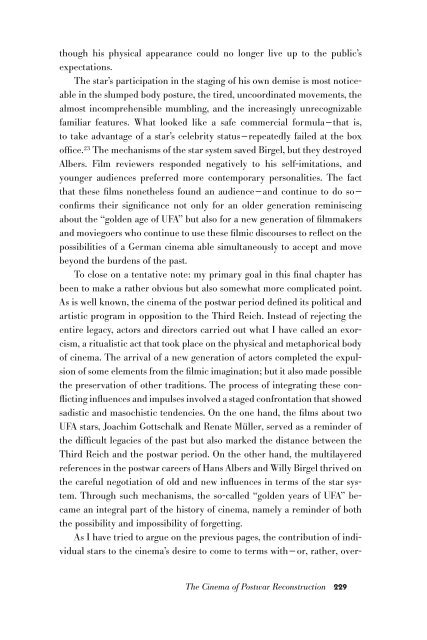You also want an ePaper? Increase the reach of your titles
YUMPU automatically turns print PDFs into web optimized ePapers that Google loves.
though his physical appearance could no longer live up to the public’s<br />
expectations.<br />
The star’s participation in the staging of his own demise is most noticeable<br />
in the slumped body posture, the tired, uncoordinated movements, the<br />
almost incomprehensible mumbling, and the increasingly unrecognizable<br />
familiar features. What looked like a safe commercial formula—that is,<br />
to take advantage of a star’s celebrity status—repeatedly failed at the box<br />
office. 23 The mechanisms of the star system saved Birgel, but they destroyed<br />
Albers. Film reviewers responded negatively to his self-imitations, and<br />
younger audiences preferred more contemporary personalities. The fact<br />
that these films nonetheless found an audience—and continue to do so—<br />
confirms their significance not only for an older generation reminiscing<br />
about the “golden age of UFA” but also for a new generation of filmmakers<br />
and moviegoers who continue to use these filmic discourses to reflect on the<br />
possibilities of a German cinema able simultaneously to accept and move<br />
beyond the burdens of the past.<br />
To close on a tentative note: my primary goal in this final chapter has<br />
been to make a rather obvious but also somewhat more complicated point.<br />
As is well known, the cinema of the postwar period defined its political and<br />
artistic program in opposition to the Third Reich. Instead of rejecting the<br />
entire legacy, actors and directors carried out what I have called an exorcism,<br />
a ritualistic act that took place on the physical and metaphorical body<br />
of cinema. The arrival of a new generation of actors completed the expulsion<br />
of some elements from the filmic imagination; but it also made possible<br />
the preservation of other traditions. The process of integrating these conflicting<br />
influences and impulses involved a staged confrontation that showed<br />
sadistic and masochistic tendencies. On the one hand, the films about two<br />
UFA stars, Joachim Gottschalk and Renate Müller, served as a reminder of<br />
the difficult legacies of the past but also marked the distance between the<br />
Third Reich and the postwar period. On the other hand, the multilayered<br />
references in the postwar careers of Hans Albers and Willy Birgel thrived on<br />
the careful negotiation of old and new influences in terms of the star system.<br />
Through such mechanisms, the so-called “golden years of UFA” became<br />
an integral part of the history of cinema, namely a reminder of both<br />
the possibility and impossibility of forgetting.<br />
As I have tried to argue on the previous pages, the contribution of individual<br />
stars to the cinema’s desire to come to terms with— or, rather, over-<br />
The Cinema of Postwar Reconstruction 229

















